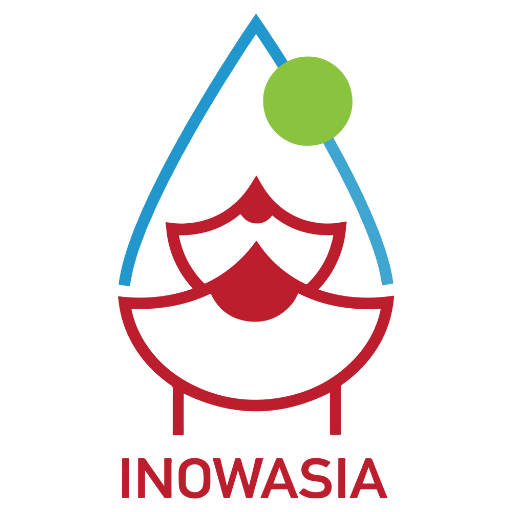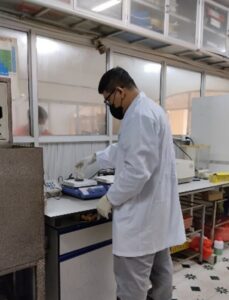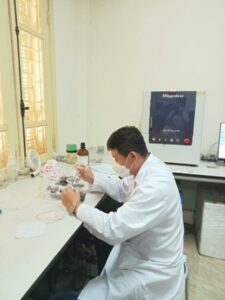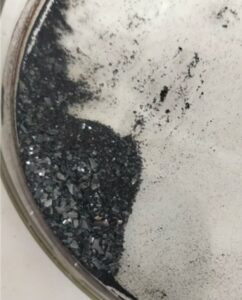

INOWASIA internship student from NUOL at VNU-HUS (Hanoi, Vietnam) for antibiotic degradation in wastewater through nanobubbles technology
I'm CHANTHAVONG Oudone, a Chemistry master's candidate at the National University of Laos, in Laos. P.D.R. I am now in a three-month internship from #INOWASIA project at the Department of Chemistry, VNU University of Science, Hanoi, Vietnam. My internship research topic is "A novel CoFe2O4/MIL-88A nanocomposite coupled with H2O2/Air nanobubbles for antibiotic degradation in wastewater." Assoc. Prof. Dr. TRAN Dinh Trinh leads this study, which is funded by the European Union's Erasmus+ program.



Sample preparation for measuring geometry using X-ray MiniFlex600
In this study, Metal Organic Frameworks (MOFs) are coupled with Advanced oxidation processes (AOPs) and Nanobubbles (NB) to degrade antibiotics in wastewater, which is divided by 4 parts as bellow.
First, literature review about theory and background about antibiotics causing water pollution. Tetracycline (TC), which was discovered in the 1940s and started to be used as a therapeutic agent in the protection of human health since the 1950s, comes first among these antibiotics, The TC is widely used in veterinary medicine as well as growth stimulation in poultry, animal care and aquaculture due to its wide usage areas, soil and surface water are contaminated with these antibiotics and their residues through leaching and runoff. The chronic toxicity of tetracycline residues can cause endocrine disruption in humans and effects on biodiversity. In addition, the long-term exposure to TC in the environment can lead to the development of antibiotic resistance in microorganisms. Moreover, TC cannot be sufficiently and completely removed by conventional wastewater treatment processes due to its persistent and toxic properties. Therefore, it is of great importance to develop efficient techniques to remove TC residues from wastewater. To tackle this problem lots of technologies and methods such as biodegradation, advance oxidation, photo-Fenton process, ozonation, membrane technology, adsorption have been developed. However, bioremediation would not be appropriate for removing antibiotics because antibiotics may harm effective microorganisms in remediation methods. Nanobubbles (NB) are tiny spherical shaped bubbles in the water with diameters less than 1 μm. Recently, NB technology has gained much attention because of its special properties like long-term stability, large specific surface area, surface energy, high oxygen dissolution rate and high mass transfer efficiency. Advanced oxidation processes (AOPs) using H2O2 have been studied and widely applied to wastewater treatment. HO• and HOO• free radicals produced by the decomposition of H2O2 in combined systems such as H2O2/Fe2+ can effectively degrade organic matters, (MOFs), a well-developed porous class of materials, are built up from metal or metal cluster connecting nodes and organic ligands. Due to their high surface area, well-distributed pore size and easily to be tailored to make specific materials, MOFs have attracted more and more attention for various applications such as gas storage, molecular sensing, adsorbents and catalyst. With these two technical advantages, the three systems were combined to have the ability of removing antibiotics in wastewater with higher efficiency. To the best of our knowledge, there is no research on coupling CoFe2O4/MIL-88A with H2O2/Nanobubble for the treatment of antibiotics. In this research we will synthesize CoFe2O4,/MIL-88A and H2O2 /NB for studying the degradation of TC as a pollutant model. with AOPs (CoFe2O4,/MIL-88A with H2O2 /NB). The products will be then characterized by means of X-ray Diffraction (XRD) for finding the geometry or shape of a molecule using x-ray, scanning electron microscope (SEM) used to obtain information about the surface topography and composition, Energy-dispersive X-ray (EDX) for generating information about the chemical composition of the nanocomposite, Brunauer-Emmett-Tell (BET) for the measurement of the specific surface area of material, Fourier transform infrared (FT-IR) for analyzing the molecular structure and composition substance …..

Synthesis of CoFe2O4/MIL-88A
The CoFe2O4/MIL-88A + H2O2 /NB was then applied for removing TC in water. In this part, there will be studies about the chemical reactions, degradation kinetics by CoFe2O4/MIL. Different parameters influencing the degradation of TC will be deployed such as effects of TC dosage and CoFe2O4/MIL-88A loading, temperature and pH. Below is the detail of my working plan:

During my internship, I hope to contribute to the existing studies on nanocomposites that can remove antibiotics in water in Southeast Asia, I also want to develop experiences in water treatment and hope to acquire more knowledge from this #INOWASIA project.
Web link:
https://inowasia.com/the-first-inowasia-internship-students-in-post-from-mid-april/
INOWASIA is an Erasmus + Capacity Building Higher Education project that promotes a joint action of 11 organisations across 5 countries (Cambodia, Laos, Vietnam, France and Spain) to train a new generation of water professionals in Southeast Asia. More info
This project has been funded with support from the European Commission. This publication reflects the views only of the author, and the Commission cannot be held responsible for any use which may be made of the information contained therein.
Project Number: 619225-EPP-1-2020-1-ES-EPPKA2-CBHE-JP
Let's Talk!
All Rights Reserved by INOWASIA 2021

